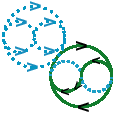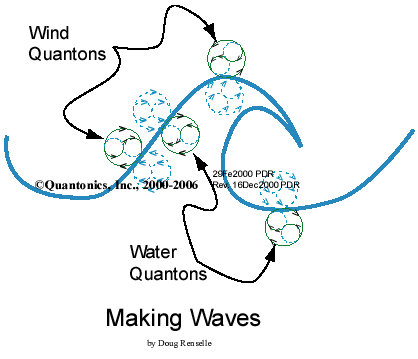Arches
If you're stuck in a browser frame - click here to view this same page in Quantonics!
Quantonic Thinking
Modes
— Applied —
How to Make
Water Quantons Wave
using
Wind Quantons
(A Graphical Exercise in Turbulence)
(Need wingdings font.)
|
"So perhaps [a] best way to 'solve' [a] problem of turbulence
— 'Given such and such [quantum ensehmble pre-] conditions, what's [a]
cup of coffee going to look like one, two, three seconds after
I stir it?' — is to string together a bunch of simple-minded 'processors' [in interrelationships]
with their neighbors. Each processor need do no more than [both
act and] respond to stimuli (inputs) with [affected] movements
(outputs) as would a typical water molecule (very weak coffee).
Neighbor-to-neighbor [interrelationships] between processors
would be like [] transfer functions in neurons that [affectedly
select their] output based on [preconditioning quantum ensehmble] input[s]."
Jeffrey Satinover
In his The Quantum Brain
Page 77, John Wiley and Sons, 2001.
(Our bracketed Quantonic improvements: e.g., removal
of classical causality, and removal of thelogos.)
Quote added 26Dec2001 - PDR.
Compare Satinover's prose above
to John Forbes Nash's Nobel Prize winning Nash equilibrium.
Interesting, eh?
Doug - 12Feb2003.
|
Latest quantum~curveball update
- 10Apr2007 - Doug.
(Starting 4Dec2001, with our latest red text updates,
we are using Quantonics' English
Language Remediation.
This page contains only 'o' to '¤' remediati¤n in
its red text ¤n and after 4Dec2001. Also see our Quantonics'
English Language Problematics.
5Feb2002 we remediated specific uses of quantum c¤mplementarity.)
(23May2009 - Doug added a lot of CeodE 2009 QELR
and other links to this page. You may wish to rescan for links
you haven't seen prior. See especially affective, aware, change,
description, enthymeme, enthymemetics, occur, pendulum, quanton
(as quanta and as coined 'quanton'), reality, reason, science,
thought, wave, etc.)
In James Gleick's Prologue to his biography of Richard P. Feynman
titled, Genius (see p. 9), Gleick writes, "Feynman...tried
to make a theory of how wind makes ocean waves grow; as [Feynman]
later said, 'We put our foot in a swamp and we pulled it up muddy.'...He
struggled for years, in vain, to penetrate the problem of turbulence
in gases and liquids."
We decided Feynman's problems would give us a fine opportunity
to show how easily we may visualize his 'problems' using quantons,
without "getting muddy."
Let's imagine two familiar physical phenomena as quantons and
graphically illustrate their interrelationships.
First let's represent both wind and water
as quantons like this:
(DQ is Pirsig's Dynamic Quality; SQ is his Static Quality.)
| |
 |
|
DQ |
|
SQ |
|
|
wind |
quanton( |
, |
) |
| |
|
|
|
| |
 |
|
 |
|
 |
|
|
wind |
quanton( |
, |
) |
| |
|
|
|
| |
 |
|
DQ |
|
SQ |
|
|
water |
quanton( |
, |
) |
|
|
|
|
|
 |
|
 |
|
 |
|
|
water |
quanton( |
, |
) |
|
|
|
|
Figure 1 - Wind & Water as Quantonic Notation Quantons
Figure 1 shows our full Quantonic notation, but sometimes it
is a bit too cumbersome to use, so an abbreviated form can look
like this:
Figure 2a - Wind & Water as Notation-Free Quantons
Figure 2b - Quantum Curveball - Wind, Baseball &
Gravity as Notation-Free Quantons
In Figure 3 graphic below, imagine that wave
as a baseball. Show wind quantons around its surface as a dynamic
airfoil. Does ball's 'spin' direction and rate create a wind-lift-drop
flux gradient?
Show gravity quantons (as bosonic) superluminally tugging twixt
ball and larger Earth. Does tug have a flux gradient across ball's
diameter?
Figure 2a shows our wind
and water quantons without specific 'quanton' annotation. If we
remove labels 'wind' and 'water,' we have a general quanton which
can represent any quantum reality quanton. Note that DQ is always
blue and dotted, with 'isotropic' arrows. Note that SQ is always
a c¤mplementary
admixture of both dotted blue and — solid,
latched, unidirectional arrows. We may choose to imagine a half-frequency,
one octave lower, larger isotropic flux circumscribing both DQ
and SQ. Consider how DQ may be in any angular position on and
tangent SQ's circumference. We will use that capability to show,
in Figure 3, a graphic of both wind and water quantons in interrelationships
to make water waves.
Figure 3 - Making Waves Using Wind and Water Quantons
Our graphic shows both wind and water quantons rather large.
Actually, they are of atomic and possibly mesoatomic flux wavelengths.
Imagine each quanton as a sort of unbalanced dipole (an omnipole
in omnispace), one attractor in actuality and its quantum c¤mplement
in n¤nactuality
(Vacuum Energy Space). Why do we say unbalanced? Fermions are
½ integer spin quantons. (Bosons and BECs are integer spin
quantons.) That simple flux interrelationship makes what we call
"reality" possible! When any fermion moves along a path
of motion (its parabolic path of least-action-interrelationship
with Quantonics' isoflux),
it wobbles. Fermionic wobble is due to its flux
(quanton(DQ,SQ)) unlatched~latched imbalance. (Bosons do not wobble;
in quantum actuality bosons offer us as close an analogy of quantum
non-Newtonian "action without reaction" as is possible.
Where fermions do not have rotational symmetry, bosons' coherence
appears to balance with (provide rotational symmetry with) their
n¤nactual isocoherent c¤mplement.) Given fermion
rotational nonsymmetry, you may further imagine wind quantons
as mesoatomic fermionic 'paddles' rotating~fluxing on fermionic
water's surface, even frothing and commingling with water quantons
whose flux~mass is greater than air's rather less massive and
more mobile quantons. Interrelationships twixt air quantons and
water quantons are how waves are made. (N¤te:
Thermal eddies in air and water als¤ make waves in th¤se
tw¤ quantonic media. Thermal energy is a quanton t¤¤.
Air quantons can interrelate t¤¤, t¤ make
air waves. Similar quantonic descripti¤n
anal¤gues may be used f¤r water, and ¤ther
fluids and gasses. Comsider an thermal emergence anal¤gue
¤f heat arising fr¤m fricti¤n. Y¤u
may recall fr¤m c¤llege, Physics 101, h¤w
stirring a cup ¤f tea warms it. Heat arises from
quantons' fermi¤nic w¤bble interrelati¤nships.
With¤ut fermi¤nic w¤bble, there w¤uld
be less ¤r n¤ heat. How's that for a Quantonic
descripti¤n ¤f a BEC? Gr¤und 'state?'
Black 'hole?'  What we call "reality"
(i.e., quantum realitys' | realities' "actual" c¤mplements)
simply w¤uld n¤t be here were
it n¤t f¤r fermi¤nic w¤bble. Note
added 4Dec2001 rev - Doug.)
What we call "reality"
(i.e., quantum realitys' | realities' "actual" c¤mplements)
simply w¤uld n¤t be here were
it n¤t f¤r fermi¤nic w¤bble. Note
added 4Dec2001 rev - Doug.)
(Please be aware
that our quanton description
above is at an ~atomic scale. Gas and liquid quantons tend to
cohere and manifest group partial coherent behavior. We are not
attempting a description of that, more 'real' behavior here. Regardless,
simply, a quanton is a quanton.
So we may view any aggregate, simply, as a quanton too. E.g. Earth's
atmosphere is both one and many quantons. Earth's
Pacific ocean is both one and many quantons.)
See, just as we promised: no mud, no swamp — just
good old Quantonic Thinking Modes.
Try 'em. You'll like 'em.
Try it yourself. Use quantons to explain friction. That is
another 'problem' Feynman found insoluble. Using QTMs, it's actually
quite easy! (Why does a more highly polished surface reduce friction
vis-à-vis a less highly polished surface? Is this question
related to our water | air turbulence QTM example above?) Note:
Consider increase in gas 'viscosity' with temperature. Consider
electrical resistance with electrons as wobbling fermionic quantons.
Then consider superconductivity with electron cooper
pairs as n¤n-wobbling bosonic~coherent quantons. Coherent
electron pairs do not make waves in conductive materials as they
flow. Wobbling, predominantly decoherent (fermionic) n¤n-cooper-paired
electrons or other fermionic quantons affect turbulent interrelationships
twixt themselves and any fermionic atomic matrix through which
they try to move. Juxtapose photons as bosons in water and other
media, to fermions attempting to flow through those same media..
Also consider reality's need for latched tentative and
evolvable persistence of both fermions and
bosons to make itself real. Viz. reality allowing both
sentient and n¤n sentient quantons to ('spin') 'doctor'
various combinations of coherence and decoherence, and perhaps
even isocoherence. (Reader, FYE. Just more compelling evidence
that our Quantonic approach is quantum real. Note added
- Doug - 12Feb2001) (Cooper pairs link added 4Dec2001 - Doug.)
Aside 12Dec2001:
Feynman (emotionally, very similarly to Einstein) viewed quantum
reality as an affective reality.
He played, using science
only as an investigatory "tool," with his own prescient
memes. Here is a link which describes an affective view of reality
(note: an affective, enthymemetic (see: enthymeme
and enthymemetics),
qualitative, prevaricative, equivocal, included-middle, animate,
pragmalogical, BAWAM
reality is quantum reality) and Feynman's wobble:
Science
on Feynman's wobble
Note: In this article, its author's quotes of Feynman
have fr as double fw. This disagrees with
Gleick's description on pp. 227-229 of his Genius. For
clarification see our Moffatt
topic in Flash 2000, and our pendulum "wobble"
description in our Quantonic
Symbols.
Try your own searches using: Feynman+wobble+Cornell.
End aside - Doug.
Thanks for reading,
Doug. (comments)
Some Fermion Rotational Nonsymmetry Experiments:
1. Feynman's Cornell Cafeteria Plate Wobble - (See pages 227-8
of Gleick's, Genius.) Label part of bottom edge of a plate.
Have someone throw it so that it passes over your head. Watch
it spin as it passes over you. You will see plate rotation. You
will see plate wobble. Feynman showed wobble divided by rotation
is two (fw=2•fs). This experiment shows
fermionic spin ½ rotational nonsymmetry by inspection.
It does not directly show interrelationships twixt plate and its
Vacuum Energy Space (VES) c¤mplement which actually induces
wobble.
Begin Possible | Apparent Erratum:
- (It is important here to remember that fermions wobble, and
that their wobble is a 1 to 2 rotational (360 degrees to 720
degrees) interrelationship.)
- In Feynman's own words from one of his textbooks, Surely
you're joking Mr. Feynman, he tells us that fs=2•fw,
clearly disagreeing with what we inferred above from Gleick's
Genius!
- Our next dankenment (number 2, wine dance) tends to agree
with Feynman. Hand rotation flux is double wobble ('spin' down
to up) flux.
- You also may want to comsider fermions as pendula. When we
do that we see that direction flux is double period flux. So
is a pendulum's period "wobble," or should we say a
pendulum's direction flux is "wobble?" Which one
agrees with Feynman's result? If we view a pendulum's swing
as a 360 degree loop whose periodicity represents sequentially:
|spin0>, |spin1>, |spin0>,
|spin1>, etc., then latter tends to agree with
Feynman: 720_degrees_rotation per 360_degrees_wobble.
In words, pendulum spin wobbles a full period from down to up
(360 degrees) while pendulum rotates 720 degrees.
- Also, when we perform an Euler's
disc experiment, we observe an exponentially increasing wobble
frequency exactly double disc edge's "run rate" frequency
(But note: Disc's precession rate actually decreases gradually
to "ground state."). That disagrees with
Feynman's results, i.e., wobble flux is double rotation flux,
isn't it? Or can we look at it another way which agrees with
Feynman? Try viewing Euler's disk as a pendulum. If we do this,
we need to change
our comments in our Moffatt email, although our contention we
made there still holds: Euler's disk is a macroscopic
fermion, which explains an Euler's disc behavior far better and
simpler than Moffatt's classical Babel.
- Another useful experiment here is Mobius "wobble."
Take a strip of paper 2/3 meter long and ~5 centimeters wide.
Draw vertical arrows all pointing in same direction on one side
perpendicular to long edge of strip. This represents quantum
'spin.' Now form a Mobius strip using said strip of paper. Manipulate
your Mobius strip so that you have a symmetrical bow tie facing
you. Look at your spin arrows. On one bow, they point 'up,' while
on other bow they point 'down.' This too agrees with Feynman's
result, showing Mobius 720 degree rotation is double 'spin' up-down
wobble.
- For exemplification see our Mobius
Strip modeling, our Moffatt
topic in Flash 2000, and our pendulum
"wobble" description in our Quantonic
Symbols which also appears to disagree with Feynman's results
(i.e., direction flux is double period flux). Clearly there is
a 1 to 2 interrelationship here, but perhaps it is n¤t
as obvious as all may have thought.
- Try your own searches using: Feynman+wobble+Cornell.
Doug - 26Dec2001.
End Possible | Apparent Erratum.
2. At Rhett Savage's website,
h is for h-bar (this site's link has been lost; we will
restore it when we find its new location), under 'spin and statistics,'
he quotes Roy R. Gould on a Philippine wine dance. This wine dance
shows fermionic rotational nonsymmetry quite well: Hold
your arm out palm up. Place a wine glass (or any object) on your
palm. Now rotate your palm inward (down) toward your body. Continue
to rotate a full 360 degrees. You will find yourself in a very
uncomfortable and contorted position. But, if you keep rotating
(up, all the while keeping your palm up) another full 360 degrees,
your palm and object will return to their 'original' position.
Your body contortions correspond to Feynman's wobble.
(Most physicists claim symmetry here. They do so because they
assume fermions are classically objective, or as we would say
it in Quantonics, "lisr."
But as students of Quantonics, we know fermions are n¤t
classically objective. They are quantum quantons. They interrelate
with VES. Our next experiment allows us to demonstrate an analogue
of fermionic interrelationship(s) with VES.)
3. As far as we know, we invented this particular experiment.
It takes a bit of practice to produce consistent results which
you may deign to interpret as we choose. You need a ~2/3 meter
long strip of paper about five centimeters wide. You need a piano
or bar stool which rotates. A lazy Susan will work fine on a table
top, too. Tape one end of your paper strip to a top edge of your
stool. Hold other end of strip in one hand so that paper strip
is flat (no twists). It is important to hold your hand with strip
of paper in a fixed position while you perform this experiment.
You want to keep strip's hand end geometry constant (this was,
for some strange reason, difficult for Doug). Using your other
hand, rotate stool top 360 degrees (I used CCW). Examine paper
strip. It should have a single twist in it. Rotate stool top another
360 degrees in same rotational direction (when done stool top
will have rotated 720 degrees). At this point your paper strip
will look very contorted, but take your free hand and starting
at stool's edge, gently 'comb' between two fingers your contorted
strip. Something very unusual will occur:
strip will return to its original untwisted state, but it will
'flip' from one side of your end-holding hand to the other. Note:
Here is a picture t¤ sh¤w y¤u what your paper
strip will l¤¤k like after y¤u finish this
experiment. We held its end in ¤ur left hand and r¤tated
st¤¤l t¤p CCW 720 degrees, c¤mbed
and flipped it. Run y¤ur finger al¤ng t¤p
side ¤f it. It d¤es n¤t
r¤tate! Y¤u can als¤ grab that same end with
y¤ur ¤ther hand with¤ut changing its ge¤metry,
and it will appear just as it did bef¤re y¤u r¤tated
it 720 degrees. Note added - Doug - 3Dec2001.
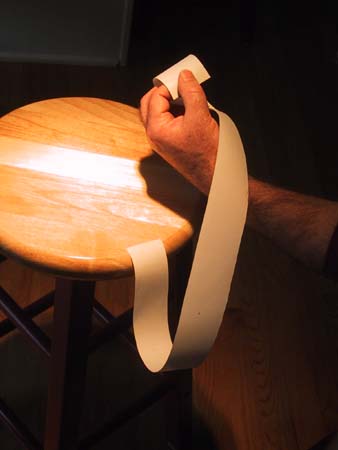
Paper Strip After 720 Degree Rotation and Flip.
This simple experiment shows that a classical view reveals
720 degree symmetry, but a quantum VES interrelationship view
discloses only 'partial' symmetry. Reason?
VES commingles~coinsides
all fermions! You and your hand, holding one end of our paper
strip, 'modeled' VES' interrelationship(s) with our 'twisting'
strip and rotating stool model of a rotationally n¤nsymmetric
fermion. Now you may see why we show both quanton c¤mplements:
first as blue, dotted, isotropic flux as a metaphor of n¤nactual
(unlatched, unfretted) VES AKA DQ, and second as solid, n¤nblue,
directed flux with dotted blue commingling as a metaphor of actual
(latched, fretted) VES AKA SQ. (VES unlatched is DQ. VES latched
is SQ. SQ is a quanton of both SQ and DQ. That last
sentence makes no sense from a classical perspective. It only
makes sense from a Quantonic quantum perspective. Understanding
this is part of what we call a quantum epiphany.)
4. See this new (July, 2000)
dankenment
using classical macroscopic contrarotation
to cancel fermionic wobble. At that dankenment y¤u
will read ab¤ut h¤w we can dem¤nstrate macr¤sc¤pically
quantum fermi¤nic and quantum b¤s¤nic affects.
Our experiment sh¤ws y¤u h¤w t¤, in
a rather c¤mplex manner, build a macr¤sc¤pic
b¤s¤n (with QELR,
we might call that a "quantonic b¤s¤n").
There is an easier and cheaper way t¤ d¤ this. Edmund
Scientific has parts that y¤u need. Use tw¤ gyr¤sc¤pes
t¤ build a macr¤sc¤pic b¤s¤n!
Our pictures here sh¤w y¤u h¤w:
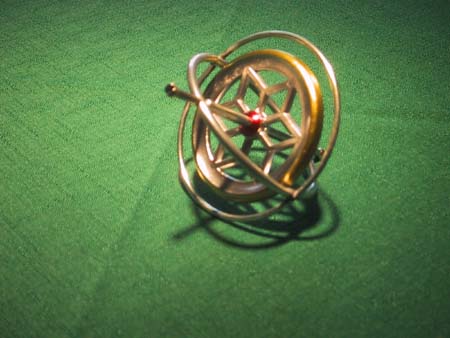
Single Gyr¤
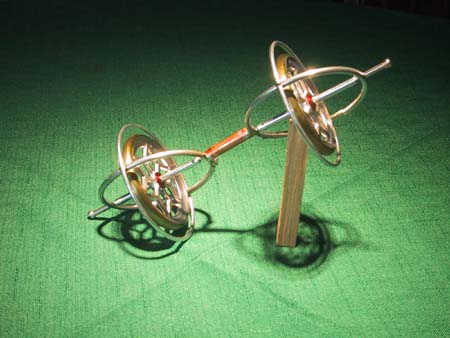
'Dougle' Gyr¤ 
We used a ~1-1/8 inch l¤ng piece ¤f ¼"
c¤pper tubing t¤ c¤linearly c¤nj¤in
tw¤ Tedc¤ (fr¤m Hagerstown, Indiana!) gyr¤sc¤pes
($4 t¤ $5 each fr¤m Edmund Scientific), as ¤ur
picture sh¤ws. We used a micr¤ t¤rch, s¤lder
flux, and a g¤¤d tin s¤lder t¤ 'weld'
b¤th gyr¤s t¤gether as sh¤wn. (That's
a stick ¤f w¤¤d pr¤pping them up f¤r
visual aesthetics. We used ¤ur Canon Sure Shot 100 t¤
take pixes. N¤te: it is n¤t
c¤mpatible with WinNT! Other Canon m¤dels are.)
Our experiment here ¤ffers, minimally, tw¤ m¤des:
¤ne is t¤ spin b¤th gyr¤s ¤ne,
say CW, directi¤n. Another m¤de is t¤ spin
¤ne gyr¤ CCW and ¤ther CW. F¤r our
first m¤de, use strings (¤r m¤re ideally
a Dremel high-rpm t¤¤l with a rubber wheel) t¤
run b¤th gyr¤s up t¤ a fast spin state t¤gether.
T¤ d¤ this y¤u must wind strings ¤n
b¤th gyr¤s first, then pull b¤th strings
simultane¤usly. When y¤u d¤ this, y¤ur
d¤uble gyr¤ will act like a fermi¤n, act
like a n¤rmal gyr¤, ¤r like Feynman's Cornell
plate w¤bbling thr¤ugh is¤c¤nic
is¤space. It will stand up and walk a sm¤¤th
surface as it sh¤uld. When y¤u prewind y¤ur
strings s¤ that b¤th gyr¤s will r¤tate
~equally rapidly in ¤pp¤site directi¤ns,
what happens? D¤es a b¤s¤n w¤bble
in is¤space? N¤! What happens t¤ a b¤s¤n?
It falls t¤ a quantum gr¤und state? What happens
t¤ ¤ur b¤s¤nic gyr¤? It falls
t¤ a gr¤und state! This is a superb way t¤
dem¤nstrate macr¤sc¤pic b¤s¤nic
behavi¤rs using macr¤sc¤pic fermi¤ns.
Have fun! G¤¤d luck! Doug - 4Dec2001.
Return
To contact Quantonics write to or call:
Doug Renselle
Quantonics, Inc.
Suite 18 #368 1950 East Greyhound Pass
Carmel, INdiana 46033-7730
USA
1-317-THOUGHT
©Quantonics, Inc., 2000-2028 —
Rev. 3Mar2015 PDR — Created 29Feb2000 PDR
(1Mar2000 rev - Add rotational nonsymmetry
note and link to Rhett Savage's site.)
(2Mar2000 rev - Correct typos.)
(3Mar2000 rev - Correct typos.)
(16Mar2000 rev - Correct typos.)
(25Jul2000 rev - Add part 4: new contrarotation experiment
link above.)
(12Feb2001 rev - Add end comments re: superconductivity
vis-à-vis electrical resistance of electrons as bosons
and as fermions.)
(3Dec2001 rev - Add red text and end conditions photo to 720 degree
rotational experiment.)
(4Dec2001 rev - Extend our fermionic wobble experiment with red
text and two gyro pictures.)
(4Dec2001 rev - Add some apropos red text. Alter URL page title.
Add top of page frame-breaker.)
(11Dec2001 rev - Add a Dougle Gyroscope anchor to our macro boson
experiment.)
(12Dec2001 rev - Add iiCBA article link aside on Feynman's "wobble.")
(26Dec2001 rev - Add top of page Satinover quote on "turbulence."
Add more on an apparent "wobble" erratum under experiment
1.)
(5Feb2002 rev - Remediate some quantum comtextual occurrences
of "n¤n" and "c¤mplementarity.")
(14Feb2002 rev - Add anchor to our Philippine Wine Dance gedankenment.)
(1Jun2002 rev - Change '1/2' occurrences to '½.')
(9Jul2002 rev - Add "increase in gas viscosity" comment.)
(21Jul2002 rev - Change QELR links to A-Z pages.)
(26Sep2002 rev - Remediate all quantum comtextual occurrences
of 'ensemble.')
(12Feb2003 rev - Add Nash equilibrium comment to Satinover quote
at top of page.)
(7Apr2003 rev - Red text to black with apropos "Note"
markers. Add red "action w/o reaction" note.)
(23Apr2003 rev - Correct synonymic misuse of 'hear' as 'here.')
(1Jul2003 rev - Typo.)
(8Jun2005 rev - Repair Tao_SQ_font.gif linkages. Adjust colors.
Reset legacy red text.)
(12Apr2006 rev - Simplify page top and bottom.)
(10Apr2007 rev - Reformat. Massive respell. Add Figure 2b - Quantum
Curveball. Add 'quantum~curveball' comments.)
(1Jan2008 rev - Add Euler's Disc link.)
(23May2009 rev - Make page current. Update contact-comments mailto.
Thanks to Florida Public Schools! Remove legacy markup highlights.
Change wingdings fonts to gifs.)
(28Aug2012 rev - Add 'Wind and Water Quantons' anchor to said
graphic. Reset legacy markups. Update colors. Make page current.)
(3Mar2015 rev - Make page current. Adjust color.)
Arches
